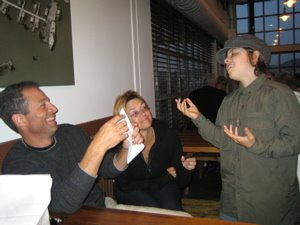



We enjoyed Andrew Condon’s hospitality in his remarkable villa of Omellons and thank him for his extraordinary generosity in showing us favorite Catalonia sights. Among them visits to a Cistercian Abbey and a mountaintop village with drop-dead vistas and most excellent Bavarians (Bavarian beer ROCKS). We even had good wi-fi at an excellent spot for food and libation called Slavia. Ben, particularly, enjoyed our stay and reaps benefits daily (CREATURES!) We have raised all of our music I.Q.s dramatically, much excellent food was eaten and and we continue to enjoy Europe’s best olive oil and spectacular almonds from Les Borges Blanques.
Of Valencia and the El Sager’s Devesa Garden “zoo”, well, its just fortunate we put off seeing it until the last as I began formulating a monkey-wrench plan almost immediately. Instead, I’ll have to express my disgust in a rap song I am working on:
YO LISTEN UP! El tig-res no son jug-etes. En abso-luto. Its something YOU know--You can’t for-get it. What-what?!
Tigers ain’t toys. Not at all. Ain’t THEIR fault, eatin’ little girls and boys--Where DO you get the gaul? DIGAME, Devesa Garden! Its in Val-encia, s’where we WENT-sia, oh yeah I’m BENT, ya-ya-yah. LIB-RE EL TI-GRE!
We did enjoy the sand, it made good sand castles.
Of Cartagena and the elephants:
After tigers, we became possessed by elephants and the Barca family and events surrounding the third century battles for settlement of Spain between the Carthaginians and the Romans. The Romans called these, the three Punic Wars and Emperor Claudius, was so impressed by the Barca effort that he used it to subdue the Celts in Britain 300 years later (it worked).
It’s 750 b.c. and Ibiza (Spain) attracts the nacent Roman civilization, before it kicks Gaulish butt in France. The problem is that Carthage, Africa, has the same idea, so around 700 b.c., they start to make pacts. Pacts are broken, people are slain and by 264 b.c., Amilcar Barca attacks the Romans in Sicily. He fails and is slain along with a Roman General, Escipio (Punic War I). Amilcar established alot of territory in southern Spain which is consolidated by another Barca, Asdrubal, who founds the Carthaginian city, Qart-Hadast (or modern-day Cartagena). Meanwhile, Rome is demanding increased tributes and Amilcar’s son, Anibal, decides to attack the Romans again but this time, at Rome. He leaves the now walled city of Qart-Hadast in 218 b.c. and leads elephants over not just the Pyrenees but also the Alps. Through winter. He attacks the Romans in Italy and wins (Punic II) but the Romans make multiple attacks and finally fell Qart-Hadast under the leadership of the son of slain Escipio (we’ll just call him Skippy). The problem is that Anibal really thinks he has won so he figures he doesnt need to sack Rome itself. Noble, but one of history’s big boo-boos. Rome tricks him and attacks at Carthage (Punic III), trapping Anibal without the army he needs. Anibal languished in Italy for years, unable to help when Carthage was being leveled by Rome, he finally committed suicide before Skippy could take him too. Rome rewards its successful legionnaires by giving them Orange, France and setting up a mini-Rome there for them--see our earlier post.
Sometime during the Punic II, there was a huge wall built to contain Qart-Hadast and we were able to crawl around in of the last remaining chunks in Cartagena. Walls just never seem to work forever, do they?
JB

















